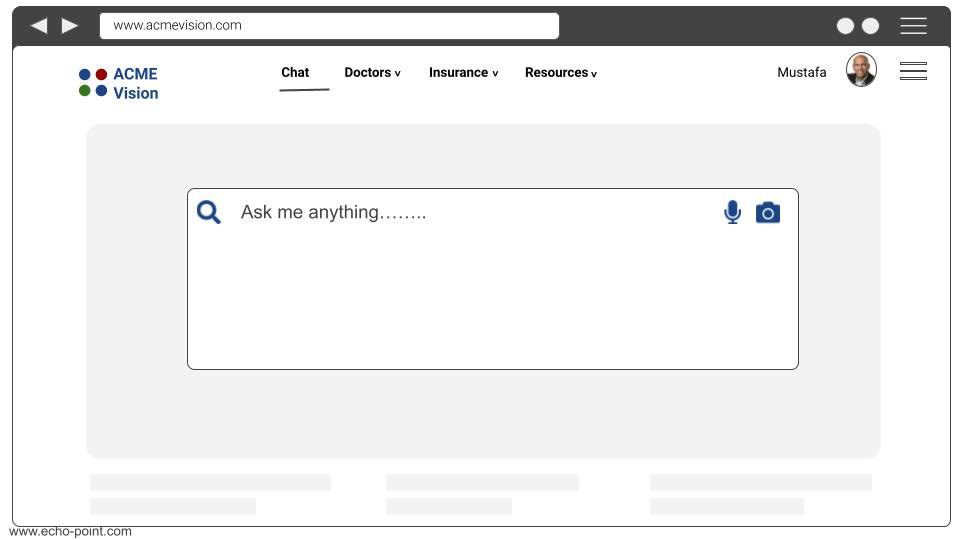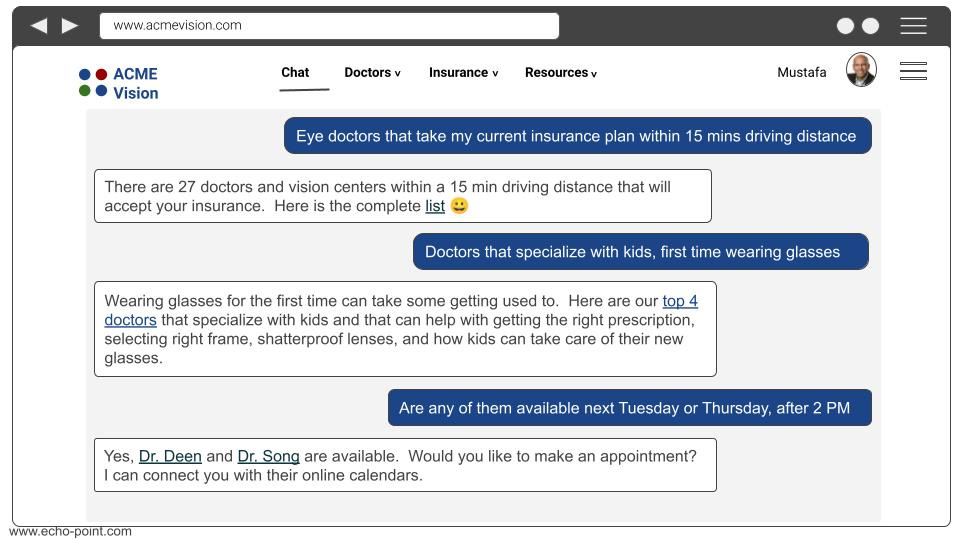35 clicks to find an eye doctor.
My son needs glasses.
So I visited the website of our vision insurance to learn about our coverage, list of optometrists, and their availability.
The sad part is that it took me over 35 clicks to figure out coverage and in-network doctors, and 5 phone calls to make an appointment.
This made me think – could ChatGTP deliver a better user experience?
To help me answer this question – let’s go back to first principles.
A website has three main jobs:
- Search: Helps users find information, products, or services. In my case insurance list of in-network optometrists.
- Transact: Assist users to complete a transaction, i.e. buy, fill out a credit card application, pay bills, make an appointment, etc.
- Troubleshoot: Help users to fix problems / resolve issues
We currently use UX to help users accomplish these jobs.
As more and more users prefer to interact with organizations online, we have heavily relied on intuitive website designs to do the heavy lifting.
For example,
1. Search:
We use menus, drop downs, banners, displays, etc., to help users navigate our site and find the information.
This works great ok for simple information. But add in volume and complexity, and this gets exceedingly harder. Try finding information from your health insurer, bank, doctor’s, DMV, or IRS website.
2. Transact:
If we break it down, web transactions are nothing more than a series of forms (user journeys) to help users complete their tasks.
And, by adding in saved information (user names, account numbers, credit card info, etc.) some of the organizations have made it easier (e.g. Amazon’s 1 click pay). Most, unfortunately, still suck. Last night, I had to click 35 times to find an optometrist.
3. Troubleshoot:
Right now the best way to resolve issues is through online FAQs, community answers, Google search, chat (agent/bots), and call centers.
If reading the above sentence causes your eyes to roll. You get my point.
The problem with using our current UX techniques is that the burden is still on the user.
But no matter how intuitive your UX is, the burden still falls on the users to figure it out.
They have to navigate the menus, follow the transaction journeys, and get the right help.
This is why so many users are confused, frustrated, or lost. They want the relevant information at their fingertips, and we make them jump through hoops.
But what if ChatGPT not UX did the heavy lifting?
Why not have a ChatGPT-like function on your home page?
Users can type in the questions (Q&A has always been human’s preferred method of communication). And ChatGPT, which is trained on just your information, can provide them with customer answers with relevant links. Or better yet do it for them.
For example…..


Yes, you can still have your menus. But your primary mode of communicating with your users will be the chat window, especially for jobs #1 and #3. As for job #2, ChatGPT can direct users to the right form
Using a ChatGPT-like function as a main method of navigation allows users to interact with the organization the way they want to interact. Starting with the question that is most important to them.
It would be simple, effective, and customized to each user.
That is as user-centric as you can get.
Happy building!!
Two Key Disclaimers
1. Mindset Limitations.
There is a saying – “When we encounter new technology. We first try to fit it in the way we are working. Only when we change the way we work to fit the new technology, is when we start to unleash its real power”.
The same can be said about the above article. We are trying to fit natural language processing into a website. Fast forward and we may not even need a website. All three jobs could be done with voice commands (just like in Star Trek).
2. Technical Feasibility.
I hesitated to write this opinion for some time now. Simply because I was not sure if this idea is technically feasible.
But in the last few weeks, I have encountered a few start-ups doing something similar. They are marrying the ChatGPT’s natural language processing capabilities and training the AI on internal information. Almost like a walled garden. So that you have quality control over the responses.
So what’s next….
Over the next few months, my goal is to leverage the Masters of Product interview series, to expose you to new ways of thinking about AI and introduce you to organizations/start-ups that are truly pushing the envelope. If you know of any organizations/individuals who are doing something interesting with ChatGPT, Midjourney, etc, please shoot me an email. I would love to interview them.
Thanks

